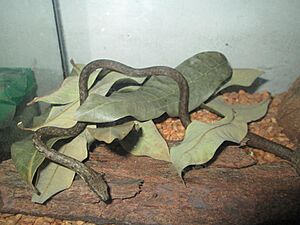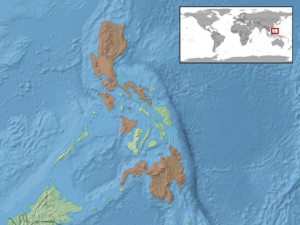Keel-bellied whipsnake facts for kids
Quick facts for kids Keel-bellied whipsnake |
|
|---|---|
 |
|
| Conservation status | |
| Scientific classification | |
| Genus: |
Dryophiops
|
| Species: |
philippina
|
 |
|
The Dryophiops philippina, also known as the keel-bellied whipsnake or Philippine whipsnake, is a type of snake. It has fangs at the back of its mouth. This snake is special because it is found only in the Philippines. Another similar snake, Dryophiops rubescens, lives in Thailand and Malaysia.
Contents
What is a Keel-Bellied Whipsnake?
The keel-bellied whipsnake, Dryophiops philippina, belongs to a group of snakes called the Dryophiops genus. A genus is like a family group for animals. This group has only one other snake, Dryophiops rubescens, which is found in Southeast Asia and Indonesia.
Dryophiops is part of a larger snake family called Ahaetuliinae. This family includes five different snake groups. Dryophiops is most closely related to the Ahaetulla and Proahaetulla snakes. You can see how they are related in the family tree below:
| Ahaetuliinae |
|
||||||||||||||||||||||||||||||
Where Do They Live?
The Dryophiops philippina snake lives only in the Philippines. It can be found on several islands there. These islands include Luzon, Mindoro, Sibuyan, Panay, and eastern Mindanao.
These snakes like to live in forests. They are found in both untouched and regrowing lowland tropical forests. They might need the trees and plants in these forests to hide and feel safe.
What Do They Look Like?
Dryophiops snakes, along with their close relatives, have long, thin bodies. Their bodies are also flattened from side to side. They have long, pointed snouts and big eyes. Their eyes have horizontal pupils, which help them see well with both eyes.
The Dryophiops philippina snake can grow to be about 3 to 6 feet long. Their color is usually dark brown or black. Sometimes they can be gray on top, with light green or pale blue spots. Their tongue is a bright red color.
They have cream or white stripes along their sides. These stripes have dark lines running through them. The snake has a wide head and a thin neck. Its eyes are large compared to its head size. The scales on its back are smooth. The scales on its belly look like they have faint dark lines. This makes them seem keeled, or ridged.
The snake's chin is white, but it can sometimes be yellow. Its neck and middle body are yellow, and the rest of its body is brown. A small scale called the preocular scale is found in front of its eye. The scales on top of its head are large. This helps tell it apart from the Dryophiops rubescens snake. Also, D. philippina does not have a truly keeled belly.
How Do They Behave?
This snake is usually calm, but it can be very nervous. If its home is disturbed, it might quickly try to escape. Sometimes, it will stay very still instead. It can remain motionless for a long time. However, it is usually always moving.
If a snake gets upset, it might puff up its neck. It shows the lighter colors underneath to look bigger. But they rarely bite. If they feel scared, they move quickly in a special way called sidewinding. They are one of the few snakes that can do this on the ground.
Even though it is a tree-dwelling snake, it often moves on the ground. You can find it among fallen leaves in the forest. This snake is active both during the day and at night.
What Do They Eat?
The keel-bellied whipsnake is a special hunter. It actively chases its food. It mostly eats geckos and other lizards. Sometimes, if it gets the chance, it might also eat small frogs, fish, or slugs.
Reproduction and Life Cycle
Like its relative, the Oriental whipsnake, D. philippina can reproduce in a special way. This is called parthenogenesis. It means the female snake can lay eggs without a male. This is rare for snakes. Most of the snakes found in the wild are females, but males do exist.
Mating usually happens from November to January. The female lays 2 to 6 eggs at a time. She often places them between tree trunks or under tree bark. These snakes can also store sperm. This means they can lay eggs multiple times after mating only once.
Female snakes have thicker bodies and shorter, thinner tails. Males are thinner and have longer tails. Females are lighter in color. Males tend to be darker, with a reddish-brown color on their heads.
In zoos or special care, these snakes usually live for about 8 years. In the wild, they can live up to 12 years.
Is Their Venom Dangerous?
Like most snakes with fangs at the back of their mouths, the keel-bellied whipsnake has mild venom. Its venom is a bit stronger than some other mildly venomous snakes. However, its small mouth and small size mean it is very unlikely to harm a healthy adult. No deaths have ever been reported from its bite.
How Are They Protected?
The IUCN (International Union for Conservation of Nature) lists this snake as Data Deficient. This means there isn't enough information to know how many of them exist. The destruction of forests is a big problem for these snakes. Forests are being cut down for farms and homes. Also, people sometimes kill snakes without knowing if they are harmful. These actions can threaten the survival of the keel-bellied whipsnake.


